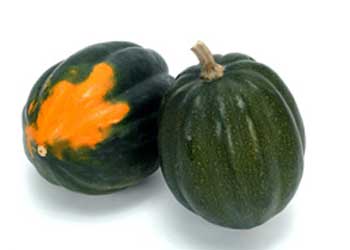Along with spaghetti and butternut squash, acorn squash is another winter fruit that seems to be popping up everywhere this time of year. I’ve seen it in recipes for soups, pastas, salads, and even pies and it all looks so gorgeous and tasty it’s growing hard to resist. However, similar to my foodie blunder of never trying butternut squash, I’ve also never tried acorn squash – shame on me. But after rounding up some seriously delicious recipes featuring it both in savory and sweet settings (find six below), I’m officially adding it to my “to try” list this holiday season and hope you’ll do the same.
Health benefits: Acorn squash is an extremely healthy winter fruit loaded with vitamins and minerals like vitamins B-12, C and A, and potassium, folic acid and manganese. It’s also considerably high in folic acid, fiber and both alpha-carotene and beta carotene, which help fight free radicals in the body and ward off certain types of cancers.
Just one cup of acorn squash contains 145 percent of the recommended daily amount of vitamin A. The same serving size also provides 15 percent of the recommended daily amount of omega 3 fatty acids, which evidence has shown can help boost heart health, lower triglycerides and even help prevent and treat serious conditions such as arthritis and depression.
Nutritional statistics: One cup contains approximately 56 calories, 0 grams fat, 15 grams carbohydrates, 2 grams fiber, 0 grams sugar and 1 gram protein.
Cooking methods: When searching for a ripe, healthy acorn squash, look for one that weighs one to three pounds – you don’t want it too big or the flavor and texture won’t be ideal. In other words, go for a smaller one if you can. The squash should feel heavy in proportion to its size and have dull, not shiny skin and no soft spots. It should be have a little orange spotting – which indicates signs of maturity – but not too many or else it will be dry and potentially stringy inside. For optimum freshness store in a cool, dry area up to one month.
When it comes to preparation methods, acorn squash can be peeled and diced before baking, cut into rings before baking or halved and then baked. The most popular method is cutting the acorn squash in half and baking face down on a greased or lightly buttered baking sheet. Bake at 375 degrees for one hour or so, until the flesh is tender. You can then dice it into cubes and sauté, add directly to salads, mash and serve as a side dish, puree and add to soups or pasta sauces, or add to baked goods such as pies and breads.
Recipes:
Roasted Acorn Squash with Chili Vinaigrette from Epicurious
Whole Grain Stuffing Apples and Toasted Walnuts
Acorn Squash Bisque from Martha Stewart
Sweet Roasted Rosemary Acorn Squash Wedges from Pioneer Woman
Acorn Squash and Honey Pie from Martha Stewart
I personally can’t wait to try the chili and honey pie. There are so many ways to enjoy this versatile winter fruit, both savory and sweet. Don’t pass on this nutritional powerhouse this winter – go out and try some for yourself!
